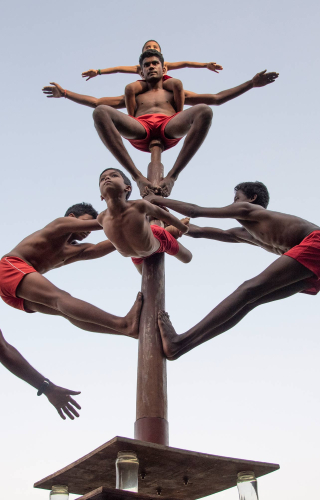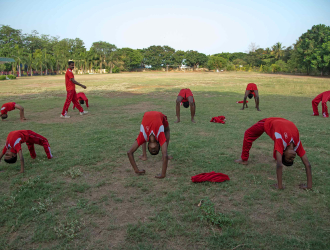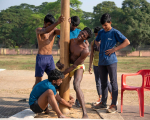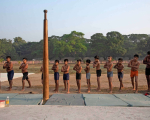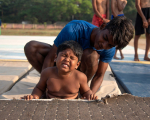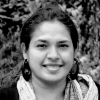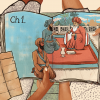Mallakhamb is an ancient Indian fitness exercise and physical training system. Mallakhamb brings together yoga, gymnastics and wrestling. The name comes from malla, meaning ‘wrestler’, and khamba, which means ‘pole’, literally meaning a ‘wrestling pole’. Initially, wrestlers trained mallakhamb to practise wrestling in the absence of an opponent. This helped them strengthen their muscles, develop agility, balance, flexibility, body coordination, and better stamina, but in later years mallakhamb developed into a sport in its own right.
According to a legend, during the reign of the last Peshwa of the Maratha Empire, Peshwa Baji Rao II (r. 1796–1818), two celebrated pehelwans (wrestlers) were sent to Pune (capital of the empire) by the Nizam of Hyderabad. These two pehelwans, Ali and Gula, challenged the peshwa darbar to wrestle them. Balambhatta Dada Deodar, a Vedic scholar and wrestler, accepted the challenge and asked for some time to prepare. He then went to the temple of Goddess Saptashrungi at Vani, in Nashik district. After weeks of meditation, the goddess appeared in his dream and guided him to seek the help of the great warrior Hanuman. He came upon the novel idea of an apparatus, a wooden pole, on which manoeuvers can be practised, similar to the arboreal locomotion of monkeys on trees. After two months of practice, he returned to Pune and defeated Ali using the yampash technique (gripping of the neck with both thighs). Gula refused to fight and Dada Deodarwas declared the winner. He, his sons, and his students later devoted their life to training wrestlers across India on the mallakhamb.
In Tamil Nadu, evidence of pole wrestling goes back to the Chola period, seen in carvings at the Brihadishvara Temple in Tanjore and at Gangaikondacholapuram, and the Airavatesvara Temple in Darasuram. It is also mentioned in the classic ‘Manasolhas’, written around 1135 CE, that wrestlers practised on a pole to maintain their agility. Wrestlers and soldiers of this era also used to practise on vazhukku paarai (Tamil for slippery rock), a monolithic rock carved in the form of the human body. It was smeared with oil to help in climbing. The rock was later replaced by a wooden pole that had a neck and head to resemble a human figure, similar to the mallakhamb.
Three types of mallakhamb are performed in the competition. In pole mallakhamb, a vertical wooden pole of teak wood or sheesam is fixed in the ground; the pole has three parts—head, neck and body, which tapers at the top. The second type also use a pole, shorter in length and hung from a hook attached to a rope, leaving a gap between the ground and the end of the pole, hence called hanging mallakhamb. The third type does not use a pole, instead, it is performed from ropes hung from a height, hence called rope mallakhamb. Both on the rope and pole, the athlete performs gymnastics and yoga poses, before making a flip landing. Irrespective of the type, every athlete has to learn the basics of gymnastics and yoga before he or she can perform mallakhamb.
In mallakhamb competitions, both boys and girls compete under four age categories—Under 12 years (Mini), under 14 years (Sub-Junior), under 18 years (Junior) and above 18 years (Senior). For girls, instead of 18 years, the junior and senior age groups are under 16 and above 16, respectively. In men’s events, only juniors and seniors have to perform hanging mallakhamb because of its difficulty. Girls of all age categories perform only the rope mallakhamb.
Mallakhamb was introduced in Tamil Nadu in 1961, by Mr Ulagadurai, a PT master in Villupuram district. Hence, he is known as the ‘Father of Mallakhamb’ in Tamil Nadu. He taught for free in different government schools for 40 years, working with youths aged 6 through 18. Mr Ulagadurai’s tireless efforts bore fruit when, in 1987, the Tamil Nadu Mallakhamb Association was formed. Mallakhamb Federation of India (MFI) came into existence in 1981, and they started national competitions the same year. In 1989, Tamil Nadu attended its first national competition in Satara, and, the next year, the event was held for the first time in Tamil Nadu, at Kanyakumari.
Among Mr Ulagadurai’s former students, Janardhanan, Ganesh, Ramachandran and Prakash played an important role in spreading the game in Tamil Nadu. Today, one-third of athletes representing Tamil Nadu for the national competition are from Tamizhan Mallakhamb Sports Academy (TMSA) run by Mr Prakash. Like his guru, he teaches for free. In order to save money on training equipment, he recycles scrap. ‘A full-size mallakhamb costs Rs. 25,000. If I make it on my own, I can save Rs. 7,000. A cushioned mat would cost Rs. 3,000. I can make it with scraps in less than Rs. 2,000,’ he says. Prakash works as a constable in the Railway Protection Force (RPF), and his contribution and dedication in developing the game are selfless. He is helped by the seniors at TMSA, who spend most of their time coaching youngsters. Their humility and discipline in truly inspiring.
Mallakhamb is tough. TMSA students are equally determined and up to the challenge. Training starts at a young age to make the body flexible. Many beginners drop out because of leg injuries or find it too difficult. Even after major injuries just days before the competition, TMSA seniors participated and won medals. There was a time when for two years Priyadarshini was the only female student at TMSA. During this period, Prakash’s pregnant wife, also an RPF constable, used to come to the ground daily to give Priyadarshini company and motivate her. On the day of his wife’s delivery, Prakash was with his students at the national competition. His sacrifice didn't go in vain as Priya won medals that day, inspiring other girls to join TMSA. ‘To me, mallakhamb is an addiction,’ says Prakash. From the money Prakash gets from the demonstration at corporates or public events, every year he conducts summer camp, coaching school students for free. Prakash’s students have also played a role in spreading awareness on mallakhamb through social media. His student, Ashok, has developed an app, Tamizhan Mallakhamb Sports Academy, the first app for mallakhamb in the world, all by himself.
In 2020, mallakhamb was included in Khelo India (started in 2019), and till now a total of 43 students (medal winners) from Tamil Nadu got scholarships of Rs. 1,20,000 per annum. SGFI (School Games Federation of India) also started giving scholarship in 2019, and till now a total of 29 students from Tamil Nadu have got 1 lakh per annum. Since 2014, colleges under Anna University, in Tamil Nadu, has included mallakhamb in their sports quota. The Tamil Nadu government has included mallakhamb in their Group C government jobs (Sports quota) as well.
In 2007, Tamil Nadu won gold for the first time at the national competition. From then on, Tamil Nadu has been giving tough competition to Maharashtra, which dominated the sport since the first nationals were held in 1981–82. Now 27 states participate at the nationals. In 2019, the increasing popularity of mallakhamb prompted the Vishwa Mallakhamb Federation to organise the 1st Mallakhamb World Championships at Dadar, Mumbai. The second Mallakhamb World Championships are scheduled to be conducted by the Mallakhamb Federation of USA in the Summer of 2021. This ancient sport of India is now reaching out to a global audience, and it is hoped that mallakhamb will be included in Asian games soon, and maybe at the Olympics.
This photo-essay has been created as part of the Sahapedia Frames Photography Grant, supported by CSR funding from IndusInd Bank.
